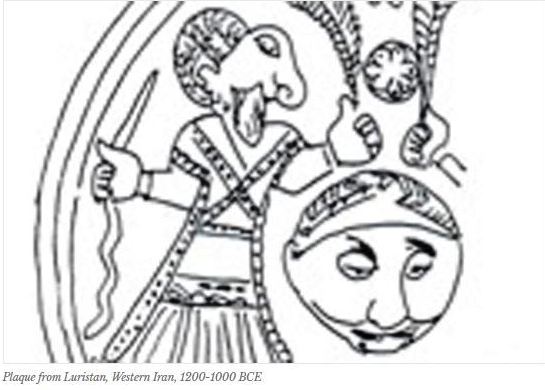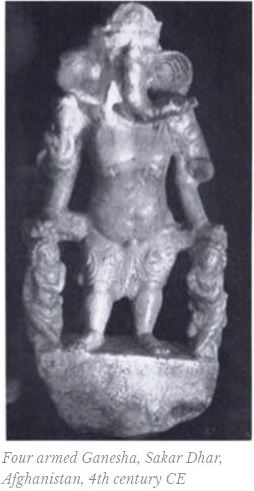The Ecology of Ganesha
by Dr. Nanditha Krishna, Historian, Author and Environmentalist, CPR Institute of Indological Research, Chennai.
The elephant-headed God as the ultimate conservation icon

In 1893, ‘Lokmanya’ Bal Gangadhar Tilak decided to utilise the Ganesha Chaturthi festival to speak out against British rule in India. He made the deity the focus of community celebration and a socio-religious movement that was intended to shake the foundations of the British Empire, uniting all Maharashtrians. In recent years, it has become a community festival all over India, with large Ganeshas that have kindled the imagination of its creators and sponsors.
But Ganesha is also a symbol of good ecology and sustainable development. Long before Lokmanya Tilak, Ganesha was worshipped in every home in the Deccan plateau. The Deccan is dependent on rainwater harvesting for its water needs. With no perennial rivers, the Deccan has always depended on rainfall, which was collected in man-made lakes, artificial tanks and wells. Every year, the lakes and tanks were desilted during the summer months, thus ensuring that they were well-maintained, and giving the landless employment during the non-agricultural period. The clay left on the tank beds and outside the wells was used to make the Ganesha images, with eyes of seeds from the Indian coral (Erythrina indica) tree. Traditionally, the clay Ganesha was never baked. After the festival, the images were immersed in the local lake, river, tank or well. Being unbaked, the clay would soften and dissolve, becoming one with the wet soil. The whole cycle was renewed the following year.
Ganesha is the remover of obstacles, his most important quality. The elephant removes obstacles in the forest, cutting through the dense undergrowth and creating pathways for man and animal. He digs holes in the ground, in search of water, creating ponds which hold rainwater and are waterholes for the entire animal population. Thus he is a facilitator. He controls the rodent population, which is the farmer’s greatest enemy. All these attributes of the elephant contributed to making the elephant-headed Ganesha into ‘Vighneshwara’, the remover of obstacles.
The elephant is the world’s largest mammal, huge and powerful yet a gentle, harmless herbivore. He is associated with wisdom, memory and longevity. He is the ultimate protector, the preventer of mishaps and a much loved animal. No wonder he is deified. The sugarcane in his hand represents an important agricultural product. The festival was one of ancient India’s methods of using religion to conserve ecology. For Ganesha has a clear ecological message.

The earliest reference to Ganapati as the Lord of the ganas is in the Rig Veda, where it is an epithet of Brihaspati and Indra, who are addressed as the Lord of the ganas. However, there is no indication whether Ganapati had an elephant head. The Taittiriya Aranyaka refers to Dantin (the tusker) with the twisted trunk (vaktratunda) who holds a sheaf of corn, sugarcane and a club. This is Ganesha as we know him. Ganas are small hardy spirits and Ganesha, as the lord of ganas, kept the spirit world in check. The name Dantin was probably the original name of Ganesha, because in Tamil Nadu, where he is very popular, he is called Pillaiyaar, which is not unlike the words pallu and pella which mean teeth, while in Pali, pillaka means a young elephant.
Ganesha was the scribe to whom Sage Vyasa dictated the Mahabharata. Ganesha agreed to the request that he should take it down, but on condition that Vyasa should dictate it without a pause. Vyasa agreed but said Ganesha should understand every word and thought and its implications before writing it down. Whenever Ganesha had completed writing, Vyasa would dictate a verse with very complex meanings so that Ganesha could ponder over it, and Vyas would get time to compose the next stanzas. Ganesha wrote the epic, the longest epic in the world, using his broken tusk as a quill or pen.

The earliest known form of an elephant-headed figure comes from Luristan in western Iran. A plaque contains an elephant-headed figure dressed as a warrior, holding a sword and snake in one hand, a quill in another. The trident is to one side and at his feet is a snake. It is dated to between 1200 and 1000 BCE (fig 1). The figure is also bearded, a sign of wisdom (as in the rishis of India and the magi of Persia). The quill, too, was a symbol of knowledge. The resemblance to Ganesha is remarkable: Ganesha is a scribe; he was born holding a trident, which is also an attribute of his father, Lord Shiva; the snake is tied around his waist or protects him. There are no Ganesha figures dating back to such an early period in India.
Afghanistan had several Ganesha figures. The earliest is probably one from Sakar Dhar (formerly Shankar Dhar), north of Kabul, where Ganesha wears a yajnopavita (sacred thread) made of a snake. The left tusk is broken and his two lower arms rest on two curly-haired ganas (fig 2). Another early Ganesha figure from Afghanistan was a Maha-Vinayaka at Gardez (fig 3). The figure was later removed to the dargah Pir Rattan Nath at Kabul where it was worshipped by local Hindus. There is an inscription saying that, ‘This great and beautiful Maha Vinayaka was consecrated by the renowned Shahi king, the illustrious Shahi Khingala.’ Ganesha figures are found all over the world: Nepal, Tibet, Sri Lanka, Myanmar, Thailand, Cambodia, Indonesia and Borneo, Kung-hsien of China, Kangiten and Kakuzencho of Japan. I even bought a Ganesha image from a mosque.

The appearance of the river Cauvery is also associated with Ganesha in a local folktale of Karnataka. Sage Agastya came down south with water in his kamandala (sacred vessel). He called out to a boy (Ganesha in disguise) passing by and asked him to hold the vessel while he went to search for a spot from where the river could flow. Ganesha left the vessel in an ideal spot that he had chosen. A crow upset it and a river began to flow from that place—the Talakaveri in Coorg.
Ganesha holds a sheaf of corn, sugarcane and club, according to the Taittiriya Aranyaka. Later, the axe and moolaka (a bulbous radish-like root eaten by elephants) were included. As a God of the Deccan farmers, he holds a sugarcane, a modaka (a sweet offering of the harvest) or a sweet laddoo and his broken tusk, which could also have agricultural associations in its resemblance to the plough.
But sadly, he also holds an elephant goad and a noose. Symbolically, the goad prods man on the path of righteousness, and the noose conveys that worldly attachments are a noose around man’s neck. However, giving the elephant-headed God the goad and the noose is dramatic irony, for these are the tools used to torture, subjugate and tame the elephant. The axe is wielded by Ganesha to destroy demons and vanquish evil. But the weapon is also used to tether and control the elephant, a veritable source of fear.
Ganesha, as we know him today, developed in the Puranic period, with the rise in importance of the Ganapatya cult. In fact, so total was his absorption that by the seventh century CE, Adi Shankara included the worship of Ganapati as one of the six systems (shanmata) of the Hindu religion.
In recent times, the community worship of Ganesha has spread all over the country, particularly in the southern states where Ganesha is a popular deity. Today’s Ganeshas are baked, made with plaster of Paris, sometimes even strengthened with cement and RCC. When these Ganeshas are immersed in water, they do not dissolve, and we see the ugly and painful sight of Ganesha images hacked to pieces. Worse, they are decorated with toxic paints. The water is polluted and becomes a toxic hazard. In many places these are the only sources of drinking water. Ganesha, a symbol of good ecology, would certainly not approve.
Source:
https://openthemagazine.com/columns/the-ecology-of-ganesha/ on 21.08.2020.